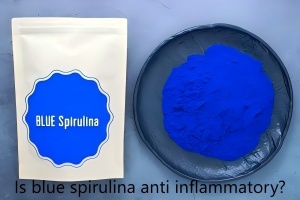Is blue spirulina anti inflammatory?

Blue spirulina, a vibrant superfood derived from algae, has caught attention for its potential health benefits, including its ability to fight inflammation. But Is blue spirulina anti inflammatory? This article explores the science behind its anti-inflammatory properties, how it works in the body, and practical ways to use it. With clear insights and research-backed information, you’ll learn why Blue Spirulina is a popular choice for those seeking natural ways to reduce inflammation and boost wellness.
What Makes Blue Spirulina Special?
Blue Spirulina is a pigment-protein complex called phycocyanin, extracted from spirulina, a type of blue-green algae. Unlike regular spirulina, it’s free of the grassy taste, making it a favorite for smoothies and colorful dishes. Packed with antioxidants, vitamins, and minerals, it’s celebrated for its potential to support overall health. Its bright blue hue comes from phycocyanin, the key compound behind its anti-inflammatory effects.
The Science Behind Its Anti-Inflammatory Power
Research shows that phycocyanin in blue spirulina has strong anti-inflammatory properties. It works by neutralizing free radicals and reducing oxidative stress, which often triggers inflammation in the body. Studies, like those published in journals such as *Inflammation Research*, suggest phycocyanin can lower inflammatory markers, potentially easing conditions like arthritis or muscle soreness. This makes it a natural option for those looking to calm chronic inflammation without relying solely on medications.
Benefits Beyond Inflammation
While its anti-inflammatory effects are a major draw, blue spirulina offers more. It’s rich in protein, B vitamins, and iron, which support energy and recovery. Its antioxidants may protect against heart disease and improve skin health by fighting oxidative damage. Some users report better immunity and less fatigue when adding it to their diet. These perks make blue spirulina a versatile supplement for overall vitality.
How to Add Blue Spirulina to Your Routine
Using blue spirulina is easy and fun thanks to its vibrant color. Start with 1/2 to 1 teaspoon daily, mixed into smoothies, yogurt, or water. Its mild flavor blends well without overpowering your recipes. For inflammation support, consistency is key—try incorporating it into your morning routine. Always choose high-quality, third-party-tested brands to avoid contaminants, as low-grade algae can carry toxins.
Is It Safe for Everyone?
Blue spirulina is generally safe for most people when taken in moderation. However, those with autoimmune conditions, allergies to algae, or certain medical issues should consult a doctor first. Overdoing it might cause mild stomach upset, so start small and monitor how your body reacts. Pregnant or breastfeeding individuals should also seek medical advice before use to ensure safety.


